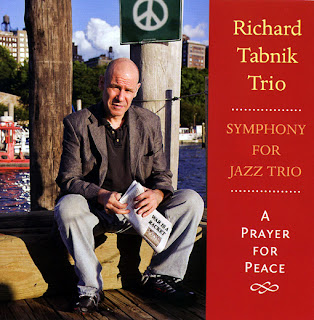Here's part two from the Notebook Series (Part one is here).
This exercise was part of my lessons with Richard Tabnik. What struck me was the simplicity, fun, and effectiveness of Richard's ideas.
He introduced this exercise to me when we started working on free improvisation. It most definitely had a flow on effect when I played tunes too - loosening and opening up the lines I played.
Over the years I have worked on it by myself, with friends (great for duos), used it as a daily warm up, and applied it to tunes (this is something I want to do more of).
Start with a single note. Hear and feel the note. Play the note - it can be loud, quiet, long or short - whatever you feel in the moment.
Relax, breathe, listen and play your next free note.
The note is what it is in that moment - don't aim to control it. Let it be free. Listen to it as you play.
Stay playing single notes until it feels right to move on to two notes - Don't rush, take your time.
Now's the time for two free notes. The process is the same. Play the note you hear in the moment, listen to that note and then play your second free note
Hear and feel the note-to-note connection between the two notes!
Hear and feel the note-to-note connection between the two notes!
Relax, breathe and listen before moving onto your next two free notes. It becomes quite meditative.
Again, continue until it feels right to move on to three free notes. And so it goes on through up to seven free notes - phrased in one breathe with rhythm, articulations, dynamics, tempo etc as you feel them in the moment.
Once you spend some time playing seven free notes it feels quite natural to move into free phrases - these do not need to be more than 7 notes (they can be though). Approach the free phrases the same way as you have the 1-7 notes groupings. Relax, breathe, listen and then play a free phrase - repeat.
Working your way back down from free phrases to seven free notes all the way back to one free note can be a blast. How does playing one free note differ now to when you started?
Find someone to trade free notes with - this is a blast. I have done this with a couple of friends, working from one note up to free phrases. Just simply trade notes - you play one free note, they play one free note etc. Eventually one player will change to two free notes, then three free notes and so on.
As I said earlier, this was passed onto me by Richard Tabnik - a wonderful alto player. Be sure to check out his music. His latest recording is Symphony for Jazz Trio (New Artists Records 2012) with Adam Lane (b) and Roger Mancuso (d) - a 2CD set featuring live and studio recordings of his three movement work "A Prayer For Peace" (plus half a dozen other pieces too). His work and teaching have had a profound impact on me - Thanks Richard!!
Again, continue until it feels right to move on to three free notes. And so it goes on through up to seven free notes - phrased in one breathe with rhythm, articulations, dynamics, tempo etc as you feel them in the moment.
Once you spend some time playing seven free notes it feels quite natural to move into free phrases - these do not need to be more than 7 notes (they can be though). Approach the free phrases the same way as you have the 1-7 notes groupings. Relax, breathe, listen and then play a free phrase - repeat.
Working your way back down from free phrases to seven free notes all the way back to one free note can be a blast. How does playing one free note differ now to when you started?
Find someone to trade free notes with - this is a blast. I have done this with a couple of friends, working from one note up to free phrases. Just simply trade notes - you play one free note, they play one free note etc. Eventually one player will change to two free notes, then three free notes and so on.
As I said earlier, this was passed onto me by Richard Tabnik - a wonderful alto player. Be sure to check out his music. His latest recording is Symphony for Jazz Trio (New Artists Records 2012) with Adam Lane (b) and Roger Mancuso (d) - a 2CD set featuring live and studio recordings of his three movement work "A Prayer For Peace" (plus half a dozen other pieces too). His work and teaching have had a profound impact on me - Thanks Richard!!
Here's the original notebook page typed up.
=============================================================================================
- Play It => 1 note! (could it be any easier?)
- Hear It
- Feel It
- Long, Short, Slow, Fast
- FF, pp
- Free It
- Sing It
- ! Be Relaxed !
- 2 Free Notes, 3, 4, 5 etc (up to 7)
- One Free Phrase (hear it, feel it)
- Another
- Another
+ Great to play/trade with another person/other people
+ Try it when playing a session/on a tune
+ By the time you have done 7 free notes for a while, Free Phrases will naturally flow - trade Free Phrases with someone.
+ After playing 1, 2, 3 etc Free Notes after Free Phrases work backwards... Free, 7, 6, 5 etc to 1 - it's quite a different feeling.
============================================================================================


No comments:
Post a Comment